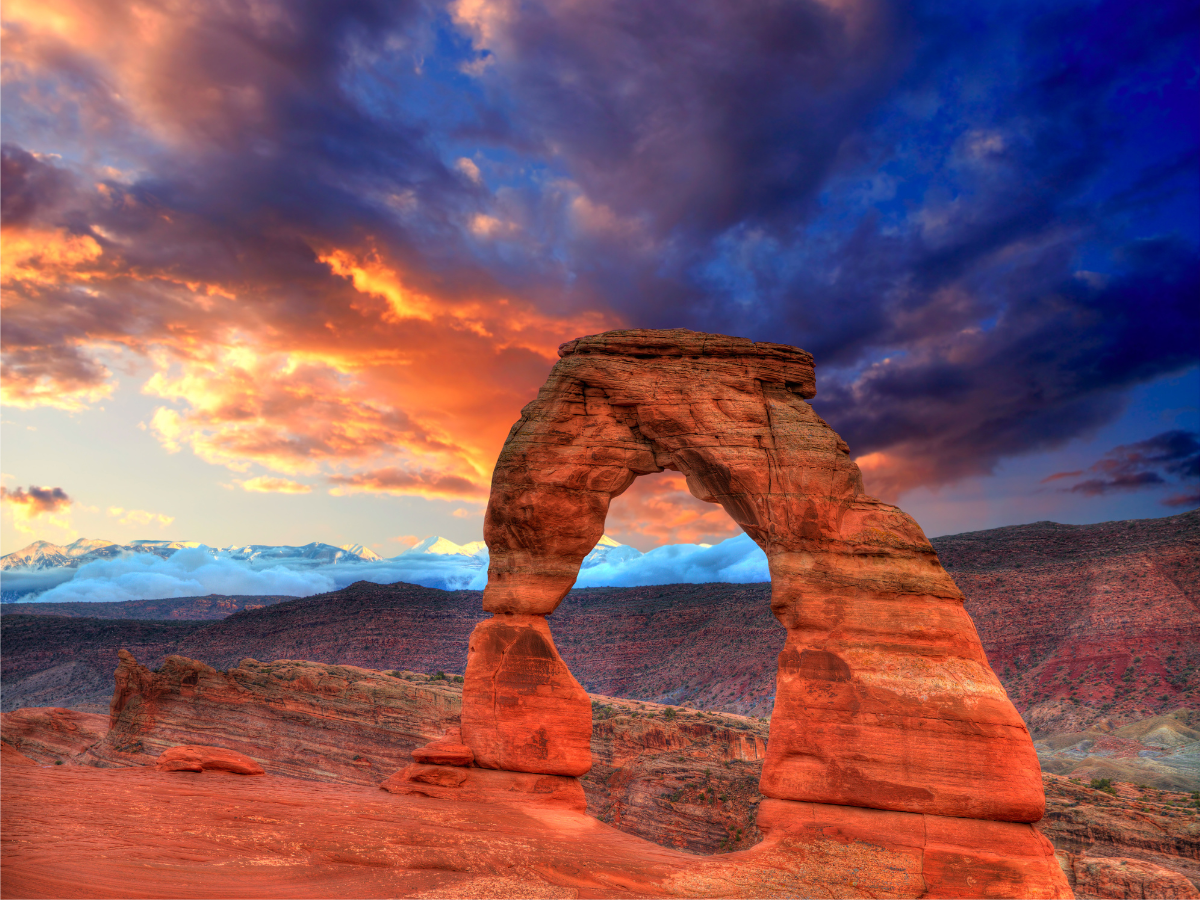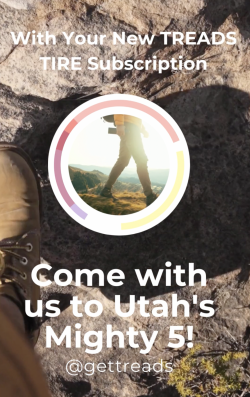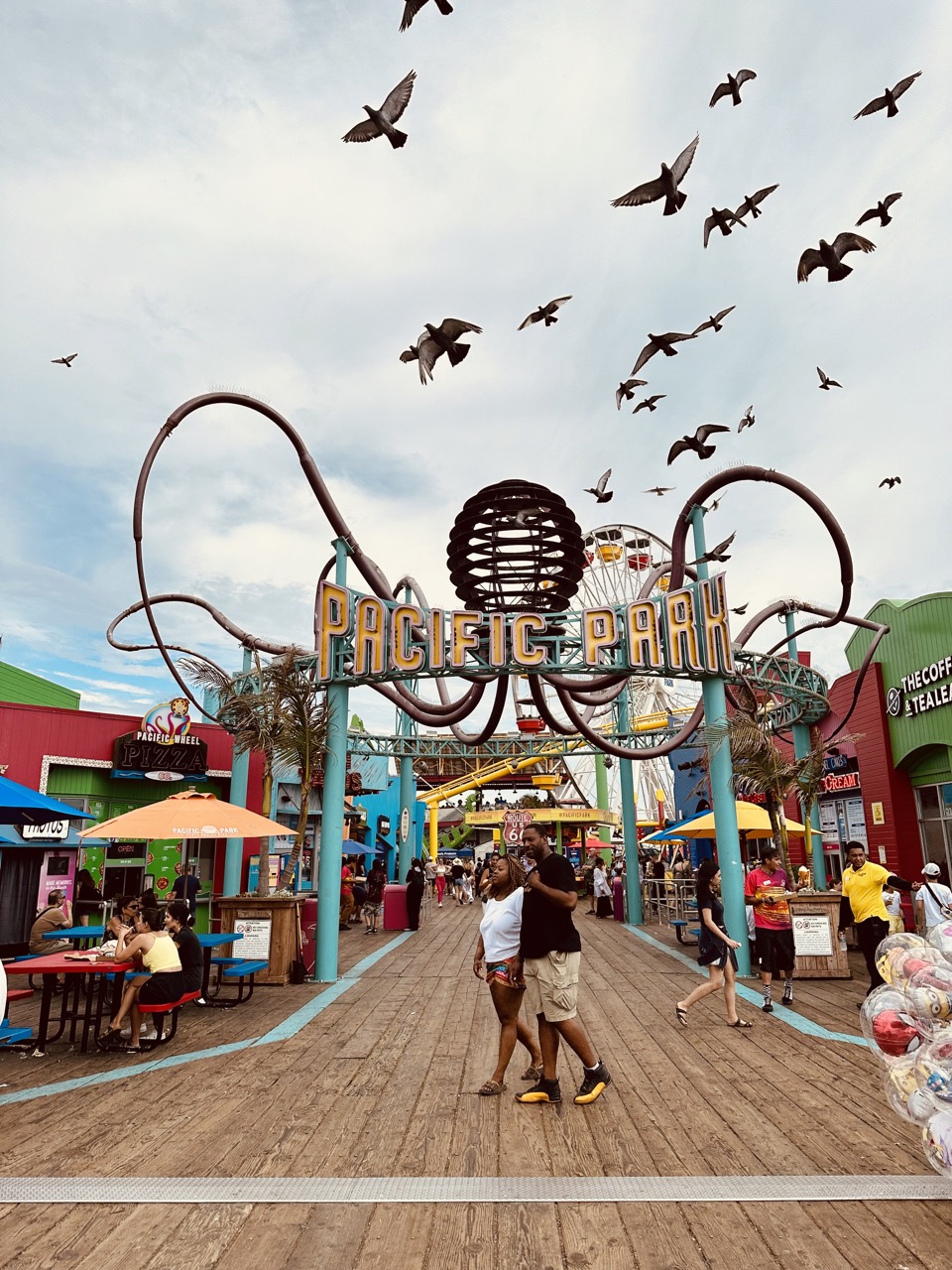Road Trip Worthy: Utah’s Mighty 5 National Parks Await Your Arrival
National parks are the crown jewels of America’s public lands. These protected areas showcase the best of what the country has to offer in terms of natural beauty, cultural heritage, and recreational opportunities. From the towering peaks of the Rockies to the sun-kissed deserts of the Southwest, each park has its unique character and charm. But if you’re looking for a quintessential American road trip, there’s no better destination than Utah’s Mighty 5 National Parks.

As the name suggests, Utah’s Mighty 5 comprises five stunning national parks: Arches, Canyonlands, Capitol Reef, Bryce Canyon, and Zion. Each park has its own distinctive landscape and geological formations, from the iconic arches and spires of Arches to the otherworldly canyons and mesas of Canyonlands. Together, these parks offer an unparalleled outdoor experience that draws visitors from around the world.
In this blog post, we’ll take a closer look at Utah’s Mighty 5 National Parks and highlight three hikes in each park – one for beginners, one for intermediates, and one for advanced or expert hikers. We’ll also delve into the history and significance of these parks, discuss the Junior Ranger program for kids, and share some insights on how to make the most of your visit with Treads tire subscription and roadside assistance.
The Role of Frederick Law Olmsted in Utah’s Mighty 5 National Parks
Frederick Law Olmsted, known as the Father of American Landscape Architecture, played a crucial role in the creation of America’s national park system, including Utah’s Mighty 5 National Parks. Olmsted was a champion for the protection and preservation of natural spaces, and his advocacy helped establish the world’s first national park, Yellowstone, in 1872.
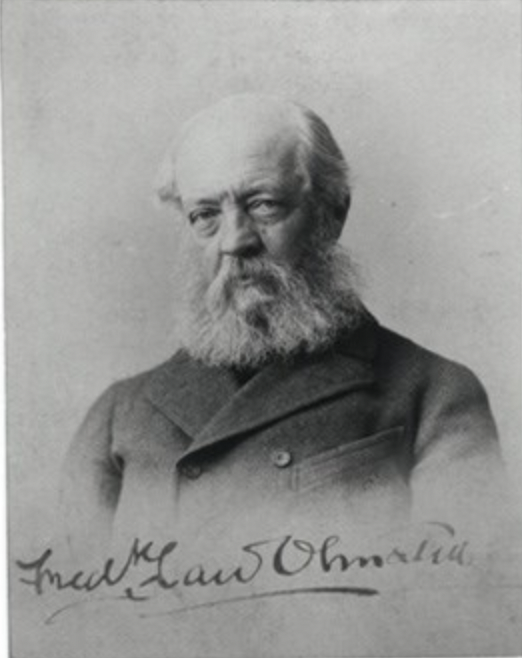
As the chairman of the commission that oversaw the establishment of Yosemite National Park in 1864, Olmsted set the precedent for preserving America’s natural wonders for future generations. His vision for public parks and open spaces extended to Utah’s Mighty 5, inspiring the creation of these iconic parks that showcase the stunning geological features and unique ecosystems of the American Southwest.
Olmsted’s legacy as a pioneer of landscape architecture and conservation lives on in Utah’s Mighty 5 National Parks, where visitors can experience the beauty and wonder of America’s natural landscape firsthand. Now, let’s get started on the fun stuff!
Arches National Park – The Red Rock Wonderland
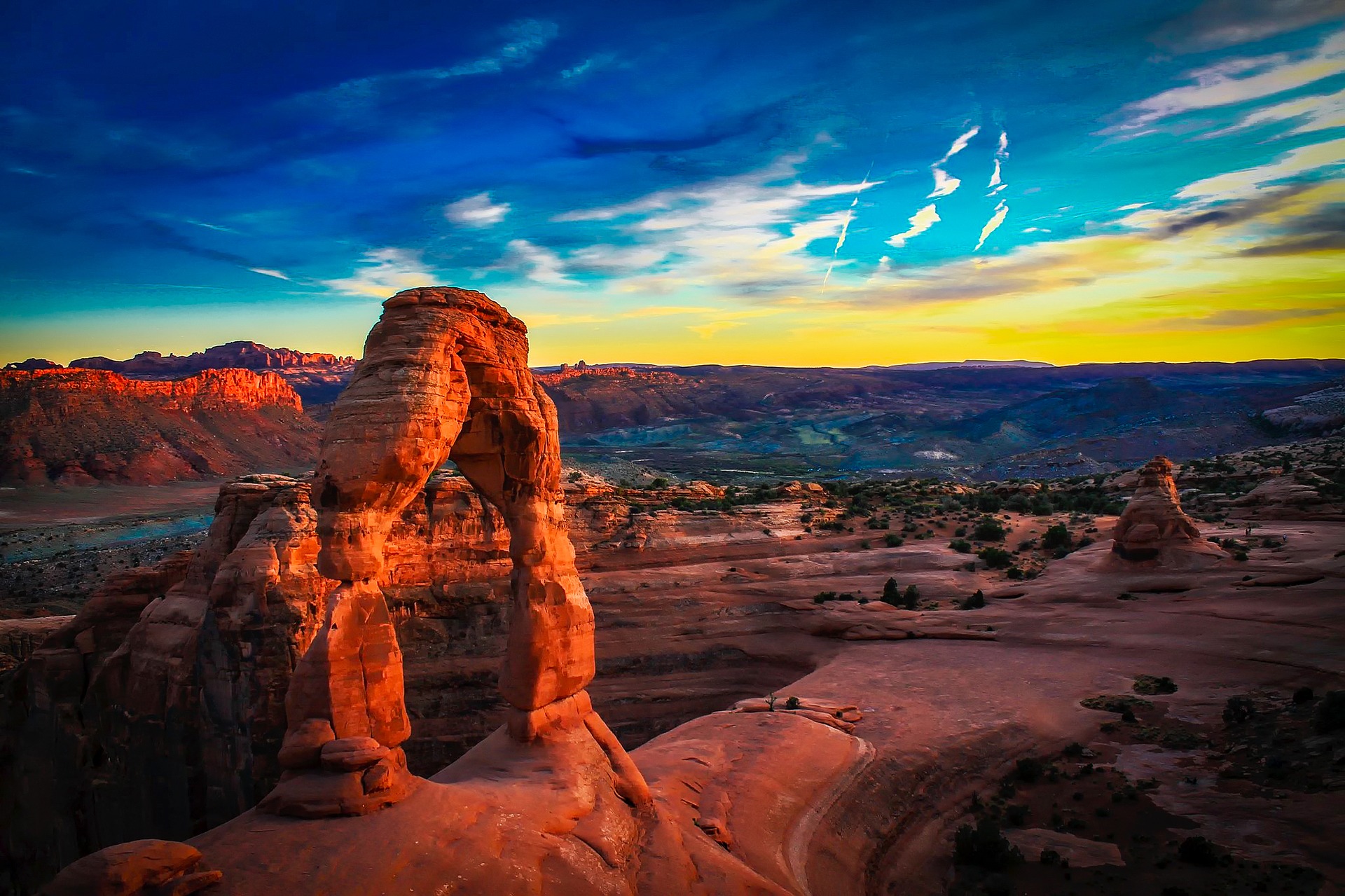
Arches National Park is a geological wonderland located in the heart of Utah’s canyon country. The park is known for its iconic sandstone arches, spires, and balanced rocks that seem to defy the laws of gravity. With over 2,000 natural stone arches, Arches is home to the largest concentration of these formations in the world.
Located in eastern Utah, Arches National Park is easily accessible by car from nearby cities like Moab and Grand Junction. To get to the park, visitors can take US-191 to the park entrance, which is located just five miles north of Moab. Once inside the park, visitors can explore the park’s many hiking trails and scenic drives, including the famous 18-mile Arches Scenic Drive.
Before visiting Arches National Park, it’s important to check the park’s website for the latest information on weather conditions, road closures, and any required reservations. The park can get very busy during peak season, so it’s a good idea to plan your visit ahead of time to avoid crowds and ensure a smooth trip.
The best time to visit Arches National Park is during the spring and fall, when the weather is mild and the park’s iconic sandstone formations are at their most vibrant. Summers can be very hot, with temperatures often exceeding 100 degrees Fahrenheit, while winters can be cold and snowy. Regardless of the season, Arches National Park is a stunning and unique destination that should not be missed.
Beginner Hike: Balanced Rock Trail
This easy 0.3-mile hike is a great introduction to Arches National Park. The trail leads to a massive sandstone rock perched precariously atop a slender pedestal, creating a dramatic and surreal scene.
Intermediate Hike: Delicate Arch Trail
This moderate 3-mile round trip hike takes you to one of the most famous landmarks in Utah – the Delicate Arch. The trail offers stunning views of the surrounding canyons and rock formations, and the arch itself is a marvel of nature.
Expert Hike: Devils Garden Primitive Loop
This challenging 7.2-mile loop takes you deep into the heart of the park’s backcountry, where you can explore hidden arches and spires that are off the beaten path. The trail requires some scrambling and route-finding skills, so it’s best suited for experienced hikers.
🤓 Fact about Arches: Did you know that some of the sandstone formations in the park have whimsical names like “The Three Gossips,” “Double Arch,” and “The Organ?
Canyonlands National Park – The Maze of Canyons
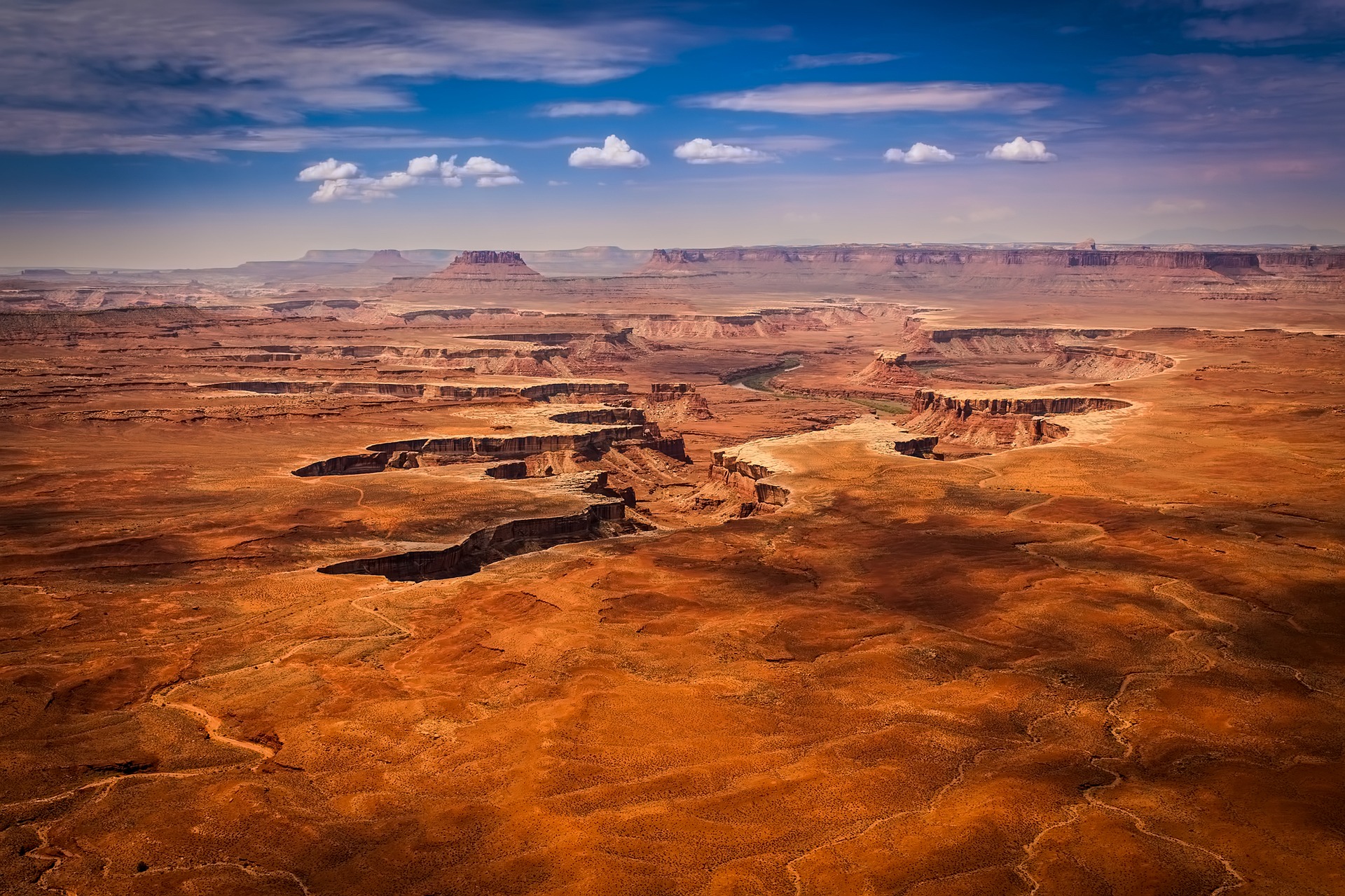
Canyonlands National Park is a vast and rugged wilderness area that encompasses over 337,000 acres of canyons, mesas, and buttes. The park is divided into four distinct districts, each with its own unique features and attractions. The Maze, located in the park’s remote western section, is considered one of the most challenging and isolated hiking destinations in the country.
Located in southeastern Utah, Canyonlands National Park is accessible by car from nearby cities like Moab and Monticello. To get to the park, visitors can take US-191 to UT-313, which leads directly to the park’s Island in the Sky district. The Needles district is located further south, and visitors can access it via UT-211 from the town of Monticello.
Before visiting Canyonlands National Park, it’s important to check the park’s website for the latest information on weather conditions, road closures, and any required reservations. The park’s remote location and rugged terrain can make for challenging driving conditions, so it’s important to be prepared and plan ahead.
The best time to visit Canyonlands National Park is during the spring and fall, when the weather is mild and the park’s iconic canyons and mesas are at their most stunning. Summers can be very hot, with temperatures often exceeding 100 degrees Fahrenheit, while winters can be cold and snowy. Regardless of the season, Canyonlands National Park is a unique and unforgettable destination that offers a true sense of adventure and exploration.
Beginner Hike: Mesa Arch Trail
This easy 0.5-mile hike leads to a stunning natural arch perched on the edge of a cliff. The arch frames a dramatic view of the canyonlands below, making it a popular spot for sunrise and sunset photography.
Intermediate Hike: Upheaval Dome Trail
This moderate 1.8-mile hike takes you to a unique geological feature – a massive crater that may have been caused by a meteorite impact. The trail offers panoramic views of the park’s stunning landscape, including the nearby Island in the Sky district.
Expert Hike: The Maze
This challenging multi-day backpacking trip takes you through some of the most remote and rugged terrain in the park. The route requires navigation skills, as there are few marked trails and no water sources along the way. But for those who are up for the challenge, The Maze offers an unforgettable wilderness experience.
🤓 Fun Fact about Canyonlands: Did you know that the park’s Maze District is so remote and rugged that it was once used by outlaws like Butch Cassidy and the Sundance Kid as a hideout?
Capitol Reef National Park – The Hidden Gem
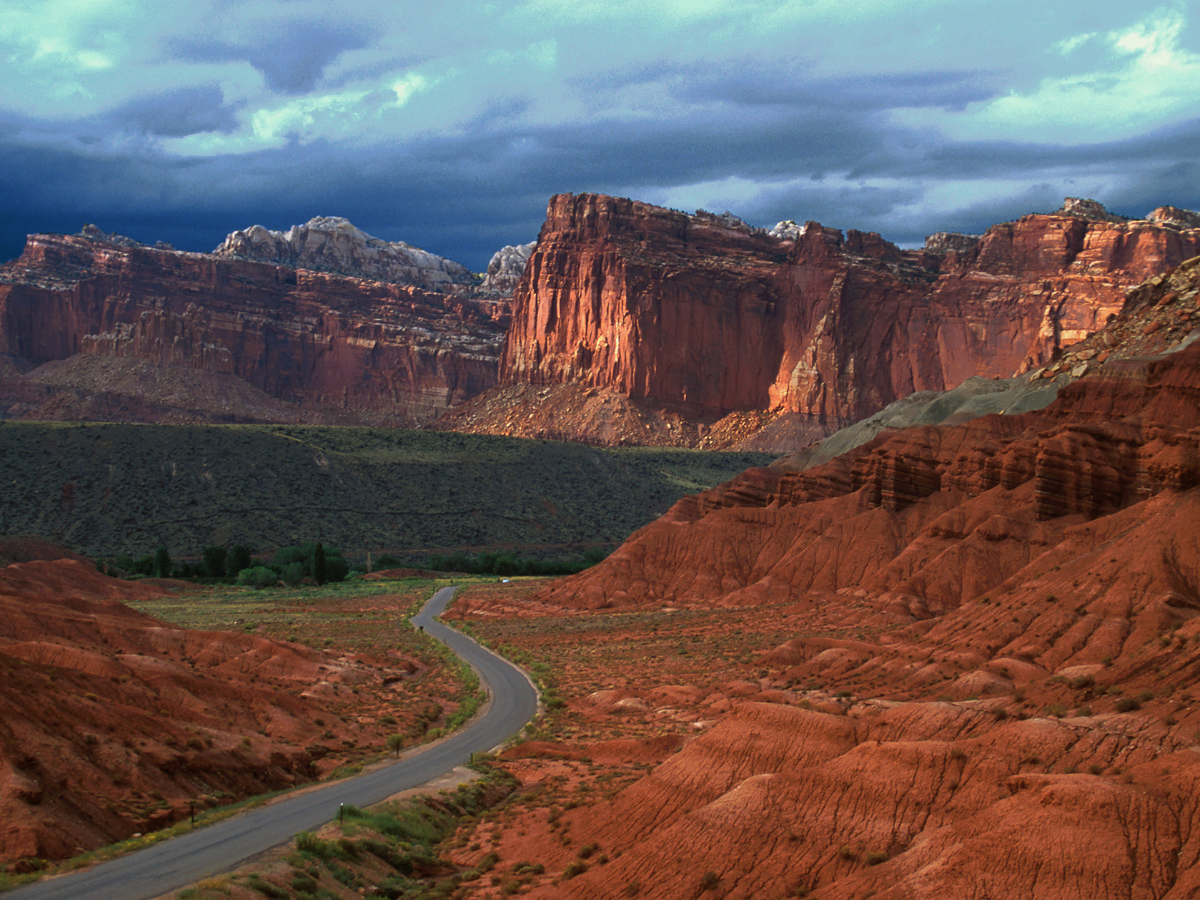
Capitol Reef National Park is a hidden gem located in south-central Utah. The park’s name comes from the towering white sandstone cliffs that resemble the dome of the U.S. Capitol. Capitol Reef is home to a rich geological history, with layers of rock that date back over 270 million years.
Capitol Reef National Park is situated in south-central Utah and can be accessed by car from nearby towns like Torrey and Hanksville. Visitors can reach the park by taking UT-24, which runs through the park’s main district and offers breathtaking views of its stunning landscapes.
Prior to visiting Capitol Reef National Park, visitors should visit the park’s website for up-to-date information on weather conditions, road closures, and any necessary reservations. Given the park’s remote location and rugged terrain, it is important to plan ahead and be prepared for challenging driving conditions.
The best time to visit Capitol Reef National Park is during the spring and fall, when the weather is mild and the park’s famous rock formations and orchards are in full bloom. Summers can be sweltering, with temperatures regularly exceeding 100 degrees Fahrenheit, while winters can be cold and snowy. Nevertheless, regardless of the season, Capitol Reef National Park is a must-visit destination that offers a captivating glimpse into the geological and cultural history of the American Southwest.
Beginner Hike: Grand Wash Trail
This easy 2.2-mile hike follows a narrow canyon that cuts through the park’s colorful sandstone cliffs. The trail offers stunning views of the surrounding landscape and is a great spot for birdwatching.
Intermediate Hike: Hickman Bridge Trail
This moderate 1.8-mile hike takes you to a massive natural bridge that spans a deep canyon. The trail passes through a scenic desert landscape and offers views of the park’s towering rock formations.
Expert Hike: Navajo Knobs Trail
This challenging 9.4-mile round trip hike offers some of the best views in the park. The trail climbs up to the Navajo Knobs, a series of towering sandstone peaks that offer panoramic views of the surrounding canyons and mountains.
🤓 Fun Fact about Capitol Reef: Did you know that the park is home to some of the best stargazing opportunities in the country? The park’s remote location and lack of light pollution make it a perfect spot to view the night sky.
Bryce Canyon National Park – The Fairyland of Hoodoos
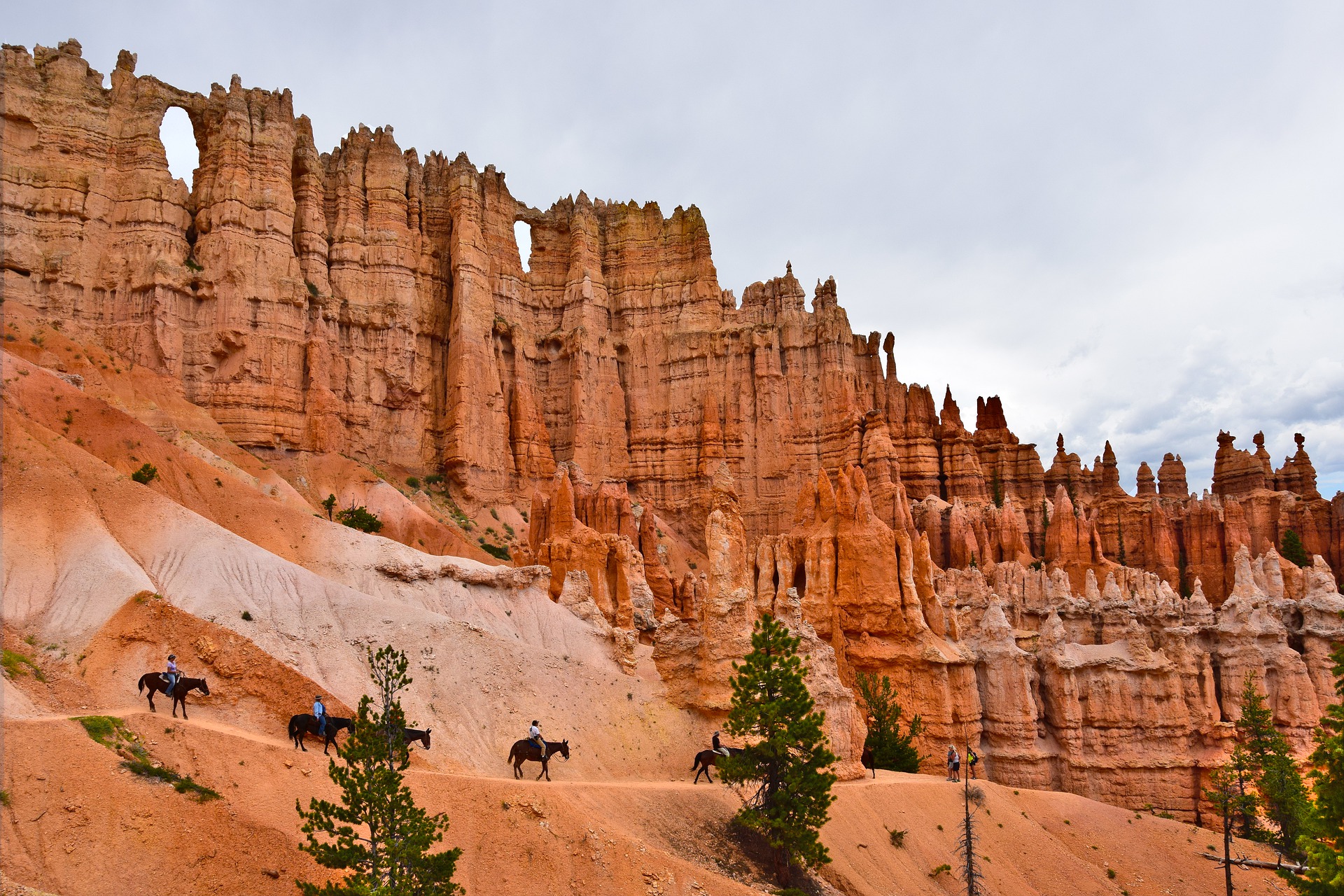
Bryce Canyon National Park is a unique geological wonderland located in southwestern Utah. The park is known for its colorful rock formations, called hoodoos, that have been eroded by wind and water over millions of years. Bryce Canyon is home to the largest concentration of hoodoos in the world, creating a surreal and otherworldly landscape.
Bryce Canyon National Park is located in southwestern Utah and is easily accessible by car from nearby towns like Bryce and Panguitch. To get to the park, visitors can take UT-12 or US-89 to UT-63, which leads directly into the park.
Before visiting Bryce Canyon National Park, it’s important to check the park’s website for the latest information on weather conditions, road closures, and any required reservations. During peak season, the park can get very busy, and visitors may need to reserve a campsite or parking spot in advance.
The best time to visit Bryce Canyon National Park is during the spring and fall, when the weather is mild and the park’s iconic hoodoos are at their most vibrant. Summers can be very crowded, with long lines and limited parking, while winters can be very cold and snowy. Regardless of the season, Bryce Canyon National Park is a unique and unforgettable destination that offers visitors a chance to witness the stunning geological formations that have been carved out over millions of years.
Beginner Hike: Queens Garden Trail
This easy 1.8-mile round trip hike takes you through a colorful canyon that is home to some of the park’s most iconic hoodoos. The trail ends at the Queens Garden, a collection of spires that resemble the figures of chess pieces.
Intermediate Hike: Navajo Loop Trail
This moderate 1.3-mile loop takes you down into the heart of Bryce Canyon, where you can explore the park’s stunning hoodoos up close. The trail includes a steep switchback section known as Wall Street, which offers incredible views of the surrounding canyon.
Expert Hike: Fairyland Loop Trail
This challenging 8-mile loop takes you on a tour of some of the park’s most spectacular hoodoos and formations. The trail is less crowded than some of the other popular hikes in the park, making it a great choice for experienced hikers looking for a more secluded adventure.
🤓 Fun Fact about Bryce Canyon: Did you know that the park is home to a unique species of bird called the Clark’s nutcracker? These birds have a specialized pouch in their throat that allows them to store and transport seeds from the park’s pine trees.
Zion National Park – The Land of Canyons and Waterfalls
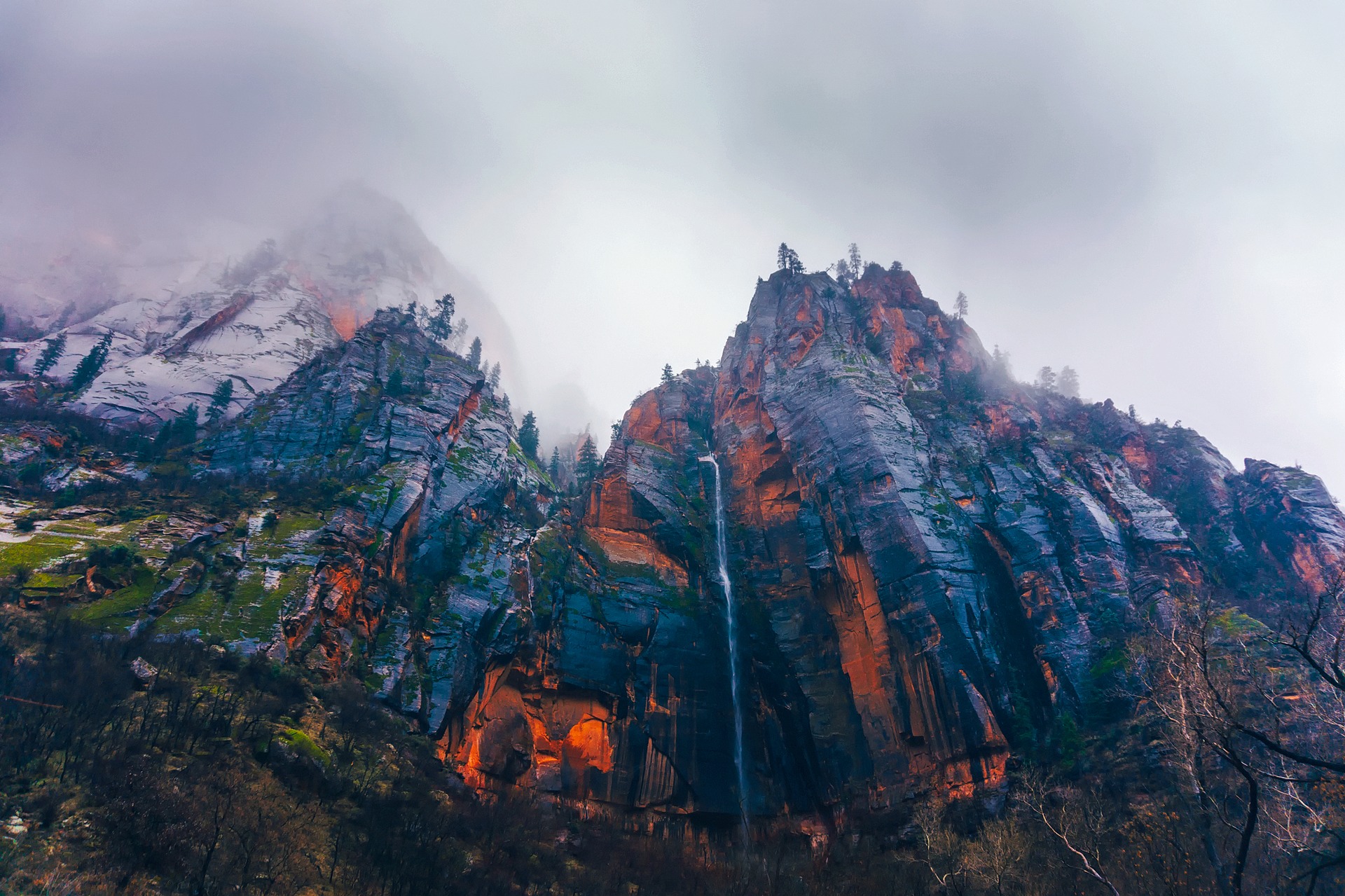
Zion National Park is a stunning natural wonderland located in southwestern Utah. The park is known for its towering red rock cliffs, deep canyons, and cascading waterfalls. Zion is home to some of the most iconic hikes in the country, including the famous Angels Landing trail.
Zion National Park is located in southwestern Utah and is easily accessible by car from nearby towns like Springdale and St. George. To get to the park, visitors can take UT-9, which leads directly into the park’s main entrance.
Before visiting Zion National Park, it’s important to check the park’s website for the latest information on weather conditions, road closures, and any required reservations. During peak season, the park can get very busy, and visitors may need to reserve a shuttle ticket or parking spot in advance.
The best time to visit Zion National Park is during the spring and fall, when the weather is mild and the park’s famous canyons and cliffs are at their most stunning. Summers can be very hot, with temperatures regularly exceeding 100 degrees Fahrenheit, while winters can be cold and snowy. Nevertheless, regardless of the season, Zion National Park is a must-visit destination that offers visitors the chance to explore its incredible landscapes and breathtaking views.
Beginner Hike: Riverside Walk
This easy 2.2-mile round trip hike takes you along the Virgin River and through a scenic canyon. The trail ends at the base of the towering Zion Narrows, a popular hiking destination for experienced hikers.
Intermediate Hike: Observation Point Trail
This moderate 8-mile round trip hike offers some of the best views in the park. The trail climbs up to the Observation Point, a towering cliff that offers panoramic views of the surrounding canyon.
Expert Hike: Angels Landing Trail
This challenging 5.4-mile round trip hike is one of the most iconic hikes in the country. The trail includes a steep ascent up a series of switchbacks, followed by a narrow and exposed ridgeline that leads to the summit. The views from the top are breathtaking, but the trail requires a steady nerve and a head for heights.
🤓 Fun Fact about Zion: Did you know that the park’s famous Zion Canyon was once home to a thriving community of Ancestral Puebloans who lived in the area for hundreds of years? Visitors can still see their rock art, dwellings, and artifacts throughout the park.
History and Significance of Utah’s Mighty 5 National Parks
Utah’s Mighty 5 National Parks are not just a geological wonderland but also a testament to the natural and cultural history of the American Southwest. The parks are home to a rich and diverse ecosystem, with unique flora and fauna adapted to the harsh desert climate. They are also home to some of the most important archaeological sites in North America, including ancient rock art, dwellings, and artifacts left behind by the indigenous peoples who have called this region home for thousands of years.
The history of these parks dates back to the early 20th century, when conservationists and environmentalists began to advocate for the protection of America’s natural wonders. In 1916, President Woodrow Wilson signed the Organic Act, which established the National Park Service and tasked it with preserving and protecting America’s national parks for future generations. Since then, the parks have become a beloved destination for millions of visitors each year, offering a unique opportunity to experience the natural beauty and wonder of the American West.
Junior Ranger Program for Kids
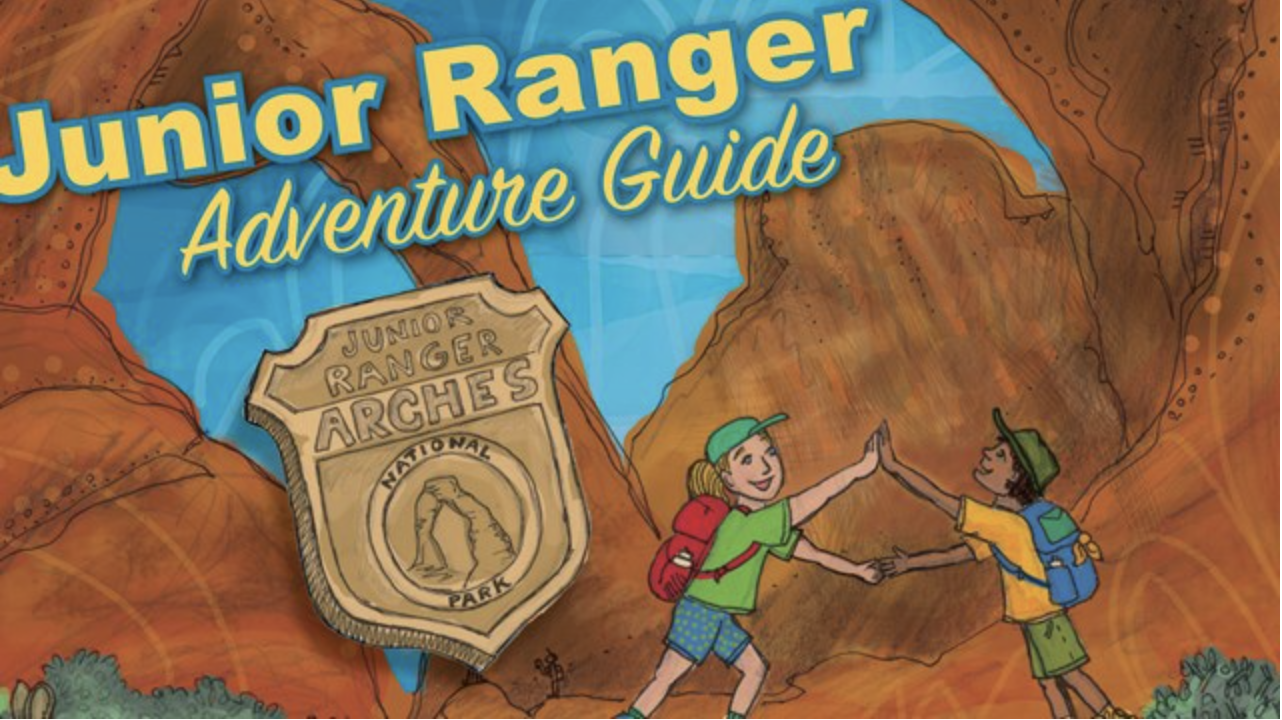
One of the best ways to experience Utah’s Mighty 5 National Parks is through the Junior Ranger program, a fun and educational program designed for kids aged 5 to 13. The program offers a variety of activities and challenges that allow kids to explore the parks, learn about their natural and cultural history, and earn a Junior Ranger badge and certificate.
The Junior Ranger program is available at all five of Utah’s Mighty 5 National Parks and is free of charge. Kids can pick up a Junior Ranger booklet at any park visitor center and complete a series of activities, such as hiking, observing wildlife, and attending ranger programs. Once they have completed the activities, they can turn in their booklet to a park ranger and receive their Junior Ranger badge and certificate.
Treads Tire Subscription 🚙🛞 and Roadside Assistance ⚠️🛠️
Visiting Utah’s Mighty 5 National Parks requires a reliable and sturdy vehicle that can handle the rugged terrain and long distances between parks. That’s where Treads comes in. Treads offers a tire subscription service that provides customers with a set of high-quality tires and 24/7 roadside assistance, making it the perfect solution for road trips and outdoor adventures.
With Treads, you can choose the tires that best suit your vehicle and driving needs and have them delivered and installed at your home, work, or wherever is most convenient for you. If you encounter any tire-related issues during your trip, you can simply contact Treads’ 24/7 roadside assistance service, and they will dispatch a service technician to your location to help you get back on the road.
Don’t Leave Your Adventure Hanging – Get a Treads Tire Subscription and Hit the Road to Utah’s Mighty 5!
Utah’s Mighty 5 National Parks are a must-see destination for anyone who loves the great outdoors. From the iconic arches and hoodoos of Arches and Bryce Canyon to the deep canyons and waterfalls of Zion, each park offers a unique and unforgettable experience. Whether you’re a beginner hiker or an experienced adventurer, there’s something for everyone in Utah’s Mighty 5.
But visiting these remote and rugged parks requires a reliable vehicle and tires that can handle the terrain. That’s where Treads comes in. With their tire subscription service and 24/7 roadside assistance, you can explore Utah’s Mighty 5 with peace of mind, knowing that you’re prepared for any adventure that comes your way. So what are you waiting for? Start planning your road trip today and discover the natural wonderland of Utah’s Mighty 5 National Parks.
Let’s Connect!
Let us know if you visit any of Utah’s Mighty 5 National Parks or sign up for a tire subscription from Treads. We’d love to hear about any experiences you have had. Connect with us on our socials: Facebook, Instagram, or TikTok. We want your 🤘🏞️ 🚙 🛞 stories!
Also for more information about a Treads Tire Subscription download the Treads App in the App Store or in Google Play and live chat with a team member with any questions you may have. We are always happy to help!

